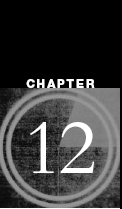Wheelchair Dolly
Applications
A dolly is critical to nearly any film that wants to appear like a professional production. Occasionally you see a film with lots of energy that has almost no dolly shots (the original Star Wars comes to mind), but most filmmakers use dollies extensively to provide their films with extra emotional power. While several dolly construction designs are provided in this book, the simplest and in some cases most effective requires not assembly at all – the wheelchair dolly.
Since the dawn of hand-held cameras, filmmakers have been using traditional wheel chairs (see figure 12-1) as a cheap and effective method of obtaining moving shots. Wheelchairs are small (so they can fit through doorways and tight spaces), light and collapsible (for easy car transportation), and smooth riding (thanks to their large rubber wheels). They’re inexpensive to rent, comfortable to sit in for several hours, and give a camera operator a great deal of flexibility in movement.

FIGURE 12.1 Use a traditional wheel chair as a flexible dolly.
Wheelchair rentals generally run about the price of a portable CD player for a week rental. This makes them a bargain in the world of film equipment rental. On a small film with good planning, you can usually schedule all of your dolly shots to be performed within that week.
Be sure to schedule the rental at least one day before its needed in principal photography. You may go to pickup the wheelchair only to find that the rental place has provided one in terrible condition (this has happened to me). A poorly maintained chair won’t provide the smooth ride that you need for a steady picture. The extra day provides time to have the rental place obtain a better one or for you to find an alternative rental location.
The effectiveness of using the wheelchair dolly begins and ends with the skill of the dolly grip pushing it. Football players seem to be the most ideal type of person to use for an untrained dolly grip. The dolly grip must be able to push the weight of the rider easily, start and stop smoothly, and push the chair consistently in either a straight line or through a curve.
Set aside some time before the day of the shoot to practice with your dolly grip. An hour of practice the day before can literally save the entire shooting day. An untrained dolly grip will be intimidated by the pressure of the shoot and the impatience of the actors. It can result in worse and worse results until you have to eliminate desires shots just to obtain the critical footage you need. Pushing a dolly is not an easy task and the more experience your dolly grip has, the better off you’ll be.
| TIP | No matter what dolly you use, recognize that dolly shoots substantially limits the possibilities of editing. With still shots, an editor can be easily cut away from the scene or to different parts of it. Dolly shots, on the other hand, generally need to be continuous. For this reason, you’ll need to schedule extra time for every dolly shot because a single mistake will require you to start the whole shot again. |
I recommend against a motorized wheelchair because I’ve attempted to use one on a shoot with fairly poor results. Most problematically, the motorized chair produces a slight jerk when stopping or starting. While nearly unnoticeable to the rider, the camera captures the jerk almost without fail. Secondly, the wheels on a motorized wheelchair are much smaller than the large wheels on a traditional chair. While this is not a problem on carpeting or smooth concrete, it almost eliminates use on rough surfaces – something a traditional wheelchair handles like a champ.
Suggestions
Here are a few operating suggestions to help you get the best use from the wheelchair dolly:
• Don’t remove the footrests In beginning practice, the footrests always seem to get in the way as you stand up and sit down again. It seems natural to remove then. Don’t. Over several hours of using your legs to hold your feet off the ground, you’ll be desperate for them back.
• Bring a tape measure Most dolly shots occur in a straight line. It is often difficult, especially with an untrained dolly grip, to keep the dolly rolling over a straight path. A tape measure with a tape lock can be laid on the ground as a quick and simple guide by which the dolly grip can judge a straight path. Be sure the camera doesn’t see the ground with the tape measure or your shot will be ruined.
• Never set the camera in the chair You’ll find that an empty chair on a set is a temptation to all to take a seat. Even if you’re careful to avoid mistakenly sitting on the camera, someone else may not be.

